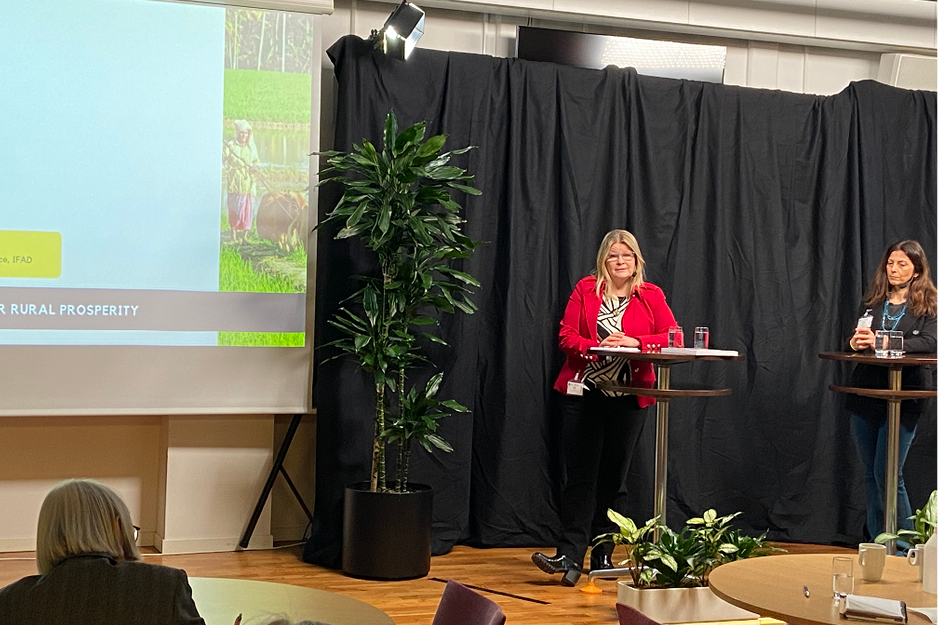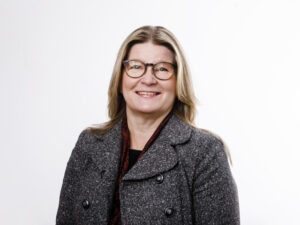This is an interview piece with Satu Santala, Associate Vice-President of the External Relations and Governance Department at IFAD
1. Recently, IFAD leadership has mentioned the harmful effects of agricultural subsidies on the market and small- and medium-sized agribusinesses. How can subsidies be tailored to better serve these groups?
Agricultural subsidies, which globally average around USD 630 billion annually, play a crucial role in the agricultural sector. However, much of this support is directed towards staple foods, dairy, and animal protein-rich foods in high- and upper-middle-income countries. This distorts markets and hinders the production of nutritious foods. These subsidies, often tied to production inputs, tend to discourage the consumption of fruits and vegetables, impacting both the environment and public health.
To better serve small- and medium-sized agribusinesses and the market, it’s essential to repurpose existing public support. This should be done thoughtfully, involving all stakeholders and considering the unique circumstances of each country. By aligning with World Trade Organization (WTO) rules and using evidence-based approaches, we can redirect subsidies to increase the availability of nutritious foods and make healthy diets more affordable worldwide. A staggering 40% of the world’s population, more than 3 billion people, could not afford a healthy diet in 2021.
The transition should also encourage the use of low emission-intensive technologies in the production of nutritious foods and align with dietary guidelines to reduce the overproduction and overconsumption of emission-intensive commodities in high- and upper-middle-income countries. This approach promotes market fairness, environmental sustainability, and affordable access to healthy diets for all. And small-scale farmers should be at the center of public support: they produce one-third of the world’s food on less than 11% of the farmland. They are efficient and contribute little to emissions. Provided with the right investments, they can lead in the transition towards sustainable, resilient, and inclusive agriculture and food systems.
2. You recently visited China to strengthen more than 40 years of cooperation. How do you see China’s increasing role as an international development donor?
IFAD’s work in China is closely linked to the government’s Rural Revitalization Strategy, which seeks to strengthen the rural economic sector, improve farmers’ living standards and curb internal migration.
Our experience in China, as in other developing countries, over the past 40 years clearly shows that investing in rural people leads to poverty reduction and economic growth beyond agriculture and rural areas. Investments in improved agricultural productivity lead to agricultural commercialization and the development of business opportunities across the agrifood industry.
Our plan going forward is to partner with China to share the valuable lessons from its successes. China holds rich experiences to be shared with the rest of the world, especially through South-South and Triangular Cooperation (SSTC). This is a way I see China’s increasing role in the international space: mobilizing knowledge, technologies and resources through SSTC to accelerate rural poverty alleviation, enhance rural productivity and advance sustainable rural transformation. As an IFAD member state, China also makes important contributions to IFAD’s core resources.
3. Could you highlight some of the significant developments you would like to see in rural development?
I would like to see by 2030 the agricultural productivity and incomes of small-scale food producers doubled. As a specific part of what this means, there are three points I would like to highlight:
First, I would like to see rural women in particular have decent opportunities. In low-income countries, up to 62 per cent of agricultural workers are women. However, only 15 per cent of land is owned by women. Women are also less able to access credit, making it harder to create resilient businesses. Providing opportunities for rural women is a key driver of agricultural productivity and increased, equitable livelihoods.
Second, we need rural areas to adapt to a changing climate, before it is too late. This means dramatically scaling up climate finance, especially directed at small-scale producers, who receive less than 2% of available climate funds. Climate adaptation financial flows to developing countries are 5 to 10 times below estimated needs, and the gap is widening. Adaptation finance reached 29 billion in 2020, but annual adaptation costs in developing countries are expected to rise to up to US$340 billion by 2030 and to more than US$500 billion by 2050, according to UNEP.
Finally, the developments I would like to see also require empowering the leadership of those who are often most marginalized. This means ensuring rural youth have voice and participation in local and global processes, and learning from Indigenous Peoples, who have lived in harmony with nature for millennia and hold many of the solutions and unique approaches needed for today’s challenges.
4. How can agriculture be made more attractive to young people, and how is IFAD empowering young women farmers who are often relegated to unpaid farm work and household tasks?
Investing in opportunities for youth and women are at the core of what IFAD does. There are millions of rural youth in developing countries who are looking for opportunities and jobs. Agriculture can provide so many opportunities, and we want to shift perceptions so young people can see the potential. As one way of doing this, IFAD has a flagship agribusiness hub model for engaging youth in rural areas. The model is designed to serve as an agile, one-stop shop for young entrepreneurs and jobseekers, by creating and accelerating businesses, brokering job opportunities for young women and men, while building more resilient rural economies.
When it comes to young women, we must find ways to provide access to, and ownership of, productive assets, like land, finance and even decision-making. This is so women can lead their own futures and businesses.
In Indonesia, I met young women farmers and agri-enterpreneurs who received funding, training and mentoring from IFAD’s project focused on rural youth. These women have improved their production and gained better market access, increasing their incomes and strengthening their social status. It was encouraging to see their excitement about prospects in agriculture.
As another example, in one project funded by IFAD in El Salvador, young rural women put up cooperatives to grow hydroponic tomatoes, showing their entrepreneurship and appetite for innovation. This opportunity has not only benefitted their families but their whole community.
5. How important is research in providing the evidence base for IFAD investments? How well does IFAD’s commissioned research align with the needs of farmers? How do you identify key knowledge gaps?
For us, research is very important to provide the evidence base for IFAD’s investments. This is also part of how we make sure funds are aligned with farmers’ and communities’ needs.
IFAD is the only international financial institution that measures the impact of its investments at the corporate level systematically every three years. In addition to reporting on corporate level impacts, we generate lessons and findings that feed into future project designs and strategies. Through close collaboration with country teams and project staff, we identify policy-relevant research questions to be addressed in the impact assessments.
For instance, IFAD 2019-2021 is an impact assessment of 24 projects representing a total investment of more than US$ 3.1 billion. Findings showed that IFAD’s investments have increased the incomes of more than 77 million people; increased the productive capacities of more than 62 million people; improved the market access for more than 64 million people; and strengthened resilience of more than 38 million people.
Care research and impact assessment also help us report on our results with credibility. We can say with evidence how, for example, IFAD’s interventions have laid the foundation for women’s empowerment, enabling women’s decision-making power, which may likely provide the basis for an increase in asset ownership in the future.
6. IFAD has launched its first-ever bond for rural development with Folksam, marking a significant milestone. What does the entry to capital markets entail for IFAD? Is there an emerging trend in capital markets?
This entry to capital markets is truly a big success. IFAD is rated AA+ by Fitch and Standard & Poor and our credit rating helps us explore new funding solutions to increase the level of resources going to those most in need and face today’s challenges. With the Folksam bond, IFAD became the first United Nations Fund and the only UN body and specialized agency other than the World Bank Group to operate on capital markets and connect investors to the rural poor.
In other words, we are trying to put global savings and wealth at the service of the most vulnerable rural people, those who produce one-third of the world’s food but are paradoxically suffering from hunger and poverty. Many of them live on the front lines of climate change and are hit the hardest by its devastating effects.
IFAD’s success with this bond indeed reflects an emerging trend in capital markets: investors are ever more interested in investing in a better world. These investors are eager to do so through credible institutions, like IFAD, institutions who can show real results and impact. I am encouraged by these trends and hope it they will help IFAD assemble more finance for where it is needed.
This interview is part of SIANI’s ‘Tune in to Food Systems’ interview series composed of monthly interview articles with experts across fields dedicated to sustainable food systems.

